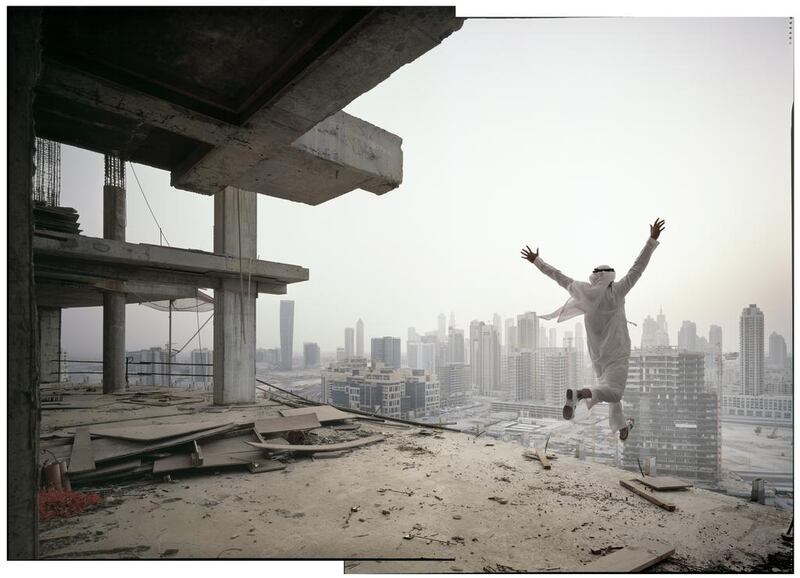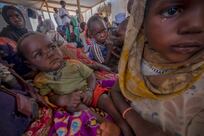It is hard to believe that less than 50 years ago, life in the UAE relied entirely on the natural environment.
When you look at photographer Richard Allenby-Pratt’s images of landscapes across the country, the devastation to the fine balance of a desert ecosystem caused by modern consumptive lifestyles is heartbreaking.
Shots of the Hajar Mountains in Fujairah reveal great trenches carved out for cement production. On one quarry site, all of the earth has receded, leaving small islands upon which native trees cling for life.
In the waters along Abu Dhabi’s coastline, heading towards Saudi Arabia, a network of channels covering a vast area have been excavated in an attempt to plant mangroves, which are precious – not least for their ability to sequester carbon.
Despite commendable intentions, the project failed and now the once vibrant sea appears flat and lifeless.
These scenes are just some of those featured in an exhibition of Allenby-Pratt’s work that is showing at Gulf Photo Plus in Dubai.
Titled Anthropocene – a new term coined for our current age, which began when human actions started to have a significant global effect on Earth's geology and ecosystems – the show contains work from several series the photographer has shot over the past 16 years.
“What I am looking at is the way exponential human development is impacting on natural ecology,” he says.
“Nature is becoming more and more marginalised, and I am not ashamed to say that there are places I have driven through over the past few years that have reduced me to tears.”
The incredible thing about Allenby-Pratt’s work is that such doom and gloom is not immediately obvious when looking at the photographs. If it were, they might not be so appealing.
In fact, in many images he uses satirical humour to draw in his audience.
In one image, for example, which previously featured in an exhibition called Abandoned in Dubai three years ago, two zebras wander across one of the city’s busy interchanges. In another, a peacock struts along a beachside development.
“I am interested in making compelling images,” says the artist, who has won several awards.
The first image you see upon entering the gallery depicts a man in local dress taking a running leap from the side of a half-built structure in what the artist calls a “joyful suicide”.
It is from a developing series called Vertigo, which Allenby- Pratt says is a comment on the economical ecosystem upon which the modern world is formed. The images are laugh-out-loud funny – until you hear the artist’s description.
“I wanted to make some images that express our approach to economics,” he says.
“Our economic system relies on growth and we live within limited space and resources, so growth is unsustainable. It is impossible for there to be sustainable growth. So, this joyful suicide is meant to be a reflection of our economic policy and that we live without considering the future.”
The success of Allenby-Pratt’s work lies in the duality of his well-researched critical message, coupled with the ironic humour and aesthetic beauty within which he chooses to present it.
He explains that photography is his tool of communication – and he wields it very effectively.
Other images in the exhibition include a series from Dubai Zoo in which he focuses on the architectural construction of the animals’ environment and highlights the cramped cages they live in. Juxtaposed with a series that he shot of luxury villas around Dubai, the message is again drenched in irony.
“This is simply showing our aspirations compared to that we allow the natural world,” he explains.
The final series on show is another landscape documentation project but this one is dedicated solely to the sabkhas, or salt plains, in Abu Dhabi’s Western Region.
These mainly coastal intertidal landscapes are so saline that almost no life can survive there, other than bacteria that can convert nitrogen into an organic form, which plants need to feed. In short, although microscopic, these cyanobacteria are essential to maintaining diverse life on this planet.
Allenby-Pratt has produced a series of images of the mirror-flat plains in Abu Dhabi, which appear barren but are actually teeming with this unseen microscopic life. The photographs are just blocks of colour from afar and up close, in which tiny glints and specks can be seen.
“Here in the UAE we have some of the best examples of this bacteria, and sabkha landscapes,” he says.
“It is fascinating because although it looks like soil, it has the most extraordinary history and significance within the ecology of this planet.
“However, at the same time it is an apocalyptic vision of what the world might look like without any natural ecology.”
That is just one of the many reasons his images are so powerful and memorable.
• Anthropocene is on show at Gulf Photo Plus until December 31. www.gulfphotoplus.com
aseaman@thenational.ae





